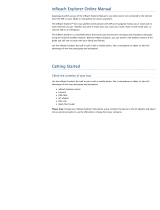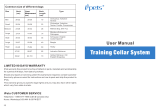
Table of Contents
Getting Started............................................................... 1
Setting Up the Alpha System...................................................... 1
Device Overviews....................................................................... 1
Alpha Handheld Device......................................................... 1
Dog Collar Device.................................................................. 1
Installing the Battery Pack.......................................................... 1
Charging the Handheld Device................................................... 2
Charging the Dog Collar Device................................................. 2
Turning On the Device................................................................ 2
Turning Off the Device........................................................... 2
Selecting a Language................................................................. 2
Using the Touchscreen............................................................... 2
Using the Status Page................................................................ 2
Acquiring Satellite Signals.......................................................... 2
Iridium® Satellite Network.......................................................... 2
Activating the Device..................................................... 3
Dog Collar Device Setup................................................ 3
Methods to Add a Dog Collar Device to a Handheld Device...... 3
Adding a Dog to the Alpha Handheld Using Wireless
Pairing.................................................................................... 3
Sharing a Dog Wirelessly.......................................................3
Adding a Dog Using the Track and Control Codes................ 3
VHF Radio Information.......................................................... 4
Managing a Group...................................................................... 4
Editing Dog Information.............................................................. 4
Resetting a Dog's Statistics and Track.................................. 4
Changing the Dog Name....................................................... 4
Changing the Color of the Dog's Track.................................. 4
Changing the Dog Type......................................................... 4
Changing the Dog ID............................................................. 4
Removing a Dog.................................................................... 4
Fitting the Collar on Your Dog.................................................... 4
Communication with the Collar................................................... 5
Entering Sleep Mode.................................................................. 5
Exiting Sleep Mode................................................................ 5
Dog Tracking.................................................................. 5
Tracking Your Dog on the Map................................................... 5
Dog Status Icons........................................................................ 5
Dog Tracking Compass.............................................................. 5
Navigating to Your Dog...............................................................5
Changing the Length of the Dog's Track.................................... 5
Location Alerts............................................................................ 6
Setting Location Alerts........................................................... 6
Editing Location Alerts........................................................... 6
Disabling Dog Data Broadcast....................................................6
Dog Training................................................................... 6
Selecting and Installing the Contact Points................................ 6
Removing the Contact Points................................................ 6
Training Methods........................................................................ 6
Linear and Traditional Stimulation......................................... 6
Choosing the Correct Intensity Level..................................... 6
Customizing the Training Keys................................................... 7
Using the Hard Keys for Training Adjustments........................... 7
Default Training Settings............................................................ 7
Collar Training............................................................................ 7
inReach Features........................................................... 7
Messages................................................................................... 7
Sending a Preset Message.................................................... 7
Sending a Text Message....................................................... 7
Replying to a Message.......................................................... 8
Checking for Messages......................................................... 8
Viewing Message Details....................................................... 8
Navigating to a Message Location
......................................... 8
Including Location Coordinates in a Message....................... 8
Deleting Messages................................................................ 8
Messages Settings.................................................................8
Tracking...................................................................................... 8
Starting Tracking.................................................................... 8
Stopping Tracking.................................................................. 8
Sharing Your MapShare™ Web Page................................... 8
inReach Tracking Settings..................................................... 8
SOS............................................................................................ 8
Initiating an SOS Rescue....................................................... 8
Sending a Custom SOS Message......................................... 9
Canceling an SOS Rescue.................................................... 9
Weather...................................................................................... 9
Requesting an inReach Weather Forecast............................ 9
Testing the Device.......................................................... 9
Connected Features....................................................... 9
Pairing a Smartphone with Your Device..................................... 9
Connecting to a Wireless Network..............................................9
Garmin Explore......................................................................... 10
Syncing inReach Data.................................................. 10
Contact Tracking.......................................................... 10
Turning On and Off the Transmitter.......................................... 10
Methods to Add a Contact to a Handheld Device..................... 10
Adding a Contact Using Wireless Pairing................................. 10
Adding a Contact Using a Contact ID....................................... 10
Initiating an Emergency Alert.................................................... 10
Sending a Message to Your Contacts...................................... 10
Tracking a Contact....................................................................11
Finding Your Contact ID........................................................... 11
Changing Your Contact ID........................................................ 11
Updating a Contact ID.............................................................. 11
Hunting with the Alpha System...................................11
Marking Your Truck Location.................................................... 11
Marking a Covey....................................................................... 11
Active Hunt Metrics................................................................... 11
Turning On the Collar Light.......................................................11
Turning On Rescue Mode.........................................................11
Pausing Dog Tracking.............................................................. 11
Waypoints, Routes, and Tracks.................................. 11
Waypoints................................................................................. 11
Marking Your Current Location............................................ 11
Marking a Waypoint Using the Map..................................... 12
Editing a Waypoint............................................................... 12
Repositioning a Waypoint to Your Current Location............ 12
Moving a Waypoint on the Map........................................... 12
Increasing the Accuracy of a Waypoint Location................. 12
Projecting a Waypoint.......................................................... 12
Deleting a Waypoint............................................................. 12
Routes...................................................................................... 12
Creating a Route.................................................................. 12
Editing the Name of a Route................................................ 12
Navigating a Saved Route................................................... 12
Editing a Route.................................................................... 12
Reversing a Route............................................................... 12
Viewing the Active Route..................................................... 12
Deleting a Route.................................................................. 12
Recordings................................................................................12
Recording Track Logs.......................................................... 12
Viewing Details about the Track.......................................... 13
Viewing the Elevation Plot of a Track.................................. 13
Navigating to the Start of a Track........................................ 13
Changing the Track Color.................................................... 13
Saving the Current Track..................................................... 13
Table of Contents i



























